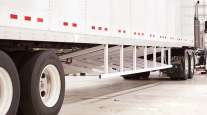Senior Reporter
Road to Zero Coalition Charts Ambitious Goal to Reduce Traffic Deaths by 2050

National Safety Council CEO Deborah Hersman evoked the memory of President John F. Kennedy when stating the goal of the newly formed Road to Zero Coalition — to dramatically reduce traffic deaths.

“We lose over 100 people a day on our roadways, and we are not outraged by each one of those deaths,” Hersman said in an interview with Transport Topics on April 23. “All of these deaths are preventable; it is like a moonshot getting to zero by 2050. But 50 years ago, sending a man to the moon seemed like it was impossible,” she said, referencing the United States’ nascent space program. “And I think it will take the same things: commitment of resources, leadership and new technology to get us to zero.”
The 675-member transportation safety coalition released a report April 22, written by the Rand Corp., which outlines how the country could reduce the number of traffic fatalities to zero by 2050.
“We have trucking companies that are members, associations that work with trucking companies, suppliers. It is going to take all of us to get to zero,” said Hersman, who served as a member of the National Transportation Safety Board for 10 years and as chairman for five years. She also holds a commercial driver license.

According to the National Highway Traffic Safety Administration, after several years of declining, the number of people who died in vehicle accidents increased by 5.6% to 37,461 in 2016, the last year figures are available.
The increase in injuries and deaths is not limited to passenger vehicles. According to NHTSA, in 2016, 4,317 people died in crashes involving large trucks. That is a 5.4% increase from 2015, and 722 of the victims were either truck drivers or occupants in the cab.
In 2016, 80% of the large trucks involved in fatal crashes had a gross vehicle weight rating of 26,000 pounds.
While the Road to Zero report focuses on the large-scale issue of traffic deaths, Hersman said the three main initiatives the coalition supports apply to trucks as much as cars:
• Doubling down on actions that have been proved to work, such as increasing seat belt usage to 100% from the current 90%. The report said half of the people who die in vehicle accidents are in the 10% group not using seat belts.
• Accelerating the use of safety technology in road construction and in vehicles.

“Technology that is available today can help make our roads safer, but when we talk about fully automated vehicles, I think that this is probably a longer time coming than most people think,” Hersman said. “There is an irrational exuberance that we are all going to have fully automated vehicles, including commercial vehicles next year. I really do not think that is how fast this is going to go.”
Also, improving the access to trauma centers where critically injured patients can receive advanced treatment. Forty-three percent of the people who die in accidents are alive at the scene of the crash.
“Much of the country that is in rural communities cannot get to a Level 1 or Level 2 trauma center, on the ground, in one hour,” Hersman said.
• Creating a culture that puts safety first, especially with regard to higher speed, distracted driving and driving under the influence. The report also said there needs to be improvement in the often difficult relationship on the highways and roads between professional truck drivers and passenger vehicle motorists.
Insurance Institute for Highway Safety, in Arlington, Va., is a member of the coalition and also has researched ways to improve vehicle safety, including trucks. “Our research looked at four technologies: blind-spot detection, forward-collision warning and mitigation, lane-departure warning and stability,” said IIHS spokesman Russ Rader, “and we found that if these systems were on all large trucks, more than one-quarter of crashes involving big rigs could be prevented or at least reduced in severity.”
IIHS said it believes that low-tech solutions also will protect passenger vehicle occupants in accidents with large trucks. NHTSA in December 2015, with a push from IIHS, proposed an upgrade to the rear underride regulations on trucks. IIHS also supports side underride guards, which are not currently required by federal regulations.
The Road to Zero Coalition concedes reaching its goal will be difficult, but Hersman said getting to zero deaths is not impossible. And like astronauts who successfully landed on and returned from the moon, it can never be accomplished until it is attempted.




